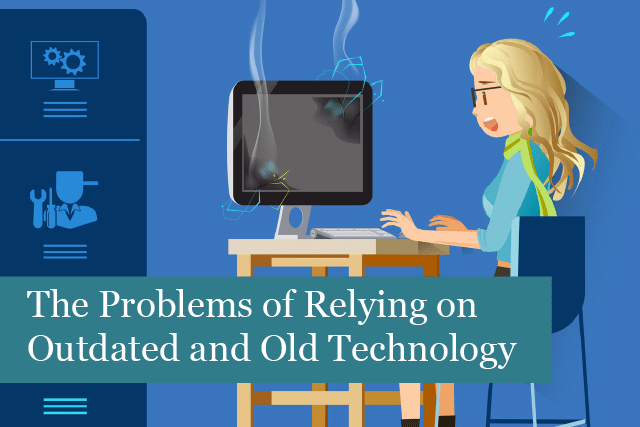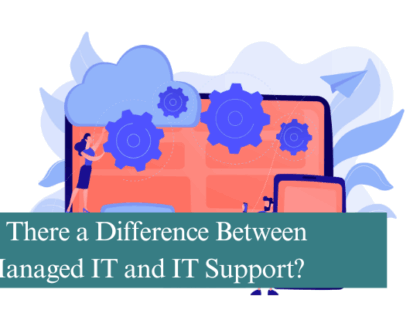
Technology changes almost as fast as lightning, at least it appears that way. What was advanced yesterday becomes outdated and old the next day. As a result, companies choose to use their legacy technology longer than they should.
Why Some Companies Don’t Update Their Tech
If updates and upgrades are so important, why are so many companies reluctant to make these necessary changes? Many businesses around the world continue to rely on legacy technology.
These reasons can include the following:
Not able to find the right solutions: it’s sometimes the case that an IT team isn’t able to find the best solution for their business. It can take time to research and evaluate new solutions and can take a lot of time and effort by the internal IT staff. IT teams are often overwhelmed to the point of not having enough time to get the research and assessments done.
- The cost: updating and making the move to new technology from legacy systems can be too expensive for some businesses.
- If it works, don’t change it: if the legacy system is still in good working order, some businesses choose to keep using it until it breaks. This is looked at as a cost-effective method that gets more value for the money that was initially invested in the technology.
- Fear of breaking the system: if the system’s working, the company may be afraid to “upset the balance” of work processes and websites. So, they continue to rely on the old system until it eventually fails. In addition, it can be time consuming and expensive to bring the in-house IT team up to speed with the new system.
While these may seem like valid reasons to keep using outdated technology, the result of relying on legacy systems can have a huge negative impact on all aspects of the business.
Why Using Old Technology is an Issue
What’s wrong with using old technology? There are several reasons that using outdated, legacy systems and software can be a problem:
1). Reduction in productivity: if your employees are working on an outdated system, their productivity will be reduced. Why? Because new technology makes it easy and faster to access and integrate systems and apps, while even making automation possible. With automation and the ease of access, employees can become more productive by working with the Cloud.
In addition, your employees will be able to work remotely from almost anywhere. This is another important reason to change to modern systems in these times of great change in the workplace.
2). Security issues & vulnerabilities: outdate technology is more susceptible to security incursions. This could be anything from a cyber data breach to an attack on your digital assets and network. Security problems put your company at risk of downtime, too. And if you’re in an industry that requires security compliance, it’s almost impossible to meet these requirements when using old hardware and software.
Working with updated tech, however, can make your company both compliant and resistant to cyberattacks. And if the worst happens and the company suffers an attack, then it’s easier and faster to get back to business with the use of updated tech.
3). Increased downtime: older technology is also prone to break down, without the help of a security breach. This is the case even with proper maintenance. The older the technology becomes, the more it will suffer from errors and downtime. This leads to a decrease in ROI and decreased productivity for employees.
4). Decline in customer service and reputation: if your company relies on old technology, then you’re taking a huge risk that your company’s reputation could be on the line. The reason is because these days customers and clients are savvier when it comes to using technology. For instance, they expect a website to work correctly and be fast. They also expect customer service to be responsive and secure. Protection of their data is also upper most in their minds.
If your company continues to rely on legacy systems and experience downtime and other issues, then the company’s reputation will take a beating. Negative experiences leave a lasting impression on customers and clients, which could lead to a decrease in your company’s reputation.
5). Higher costs: maintaining legacy technology and software comes with a higher cost. As the tech becomes more outdated, it will definitely fail more often. It will be harder to find service providers who can get you back up and running, because they are using the newer systems, while the business continues to rely on older systems. As a result, maintenance of all kinds will only become more expensive over time.
6). Compatibility problems: relying on older systems can also lead to compatibility issues. This comes when you try to use newer technology with the legacy system. It may be impossible to get the two working well together. In addition, you won’t be able to make full use of the new technology, which can take away your company’s competitive edge.
7). Environmental impact: in these days of environmental concern about sustainability, companies that choose to rely on outdated technology become less energy efficient, and instead increase their environmental footprint. Consuming too much energy and/or resources can make your business look bad, and it will increase your expenses due to the higher energy needed to run legacy systems.
Does Your Technology Need to be Updated?
Do you know what to look for when your tech needs to be updated? Here are some signs it may be time to upgrade and update your systems:
- Your systems have become slow and clunky; they may also no longer be reliable.
- Software has reached or gone past the end of life. In this case, it’s no longer supported by the provider.
- Your systems suffer repeated cyberattacks.
- Your company has grown, and your legacy systems and software can not meet your business needs.
- Your security is non-compliant with your industry’s require compliance standards.
These are all clues it’s time to upgrade and update to new technology. Not doing so will harm your brand, the company’s reputation and you could even lose customers/clients and partners. Your business will drastically suffer as a result.
How Often is it Recommended to Update Technology?
Here are some recommendations on how often your technology should be upgraded & updated:
- Desktop computers: they should be replaced about every 5 years.
- Laptop computers: these should be replaced about every 3-4 years.
- Servers: experts recommend servers should be replaced about every 4-5 years.
- Operating systems: these should be updated as often as possible, when the provider notifies an update’s available. Everyone in the company needs to keep their devices updated, too.
As you can see, using outdated technology has no benefits for your company. On the other hand, making the change to updated systems and tech can have huge benefits the company can enjoy for years to come. It’s well worth the investment to make the change to update legacy technology at all levels.
Recommended Posts

Is There a Difference Between Managed IT and IT Support?
13th June 2025


